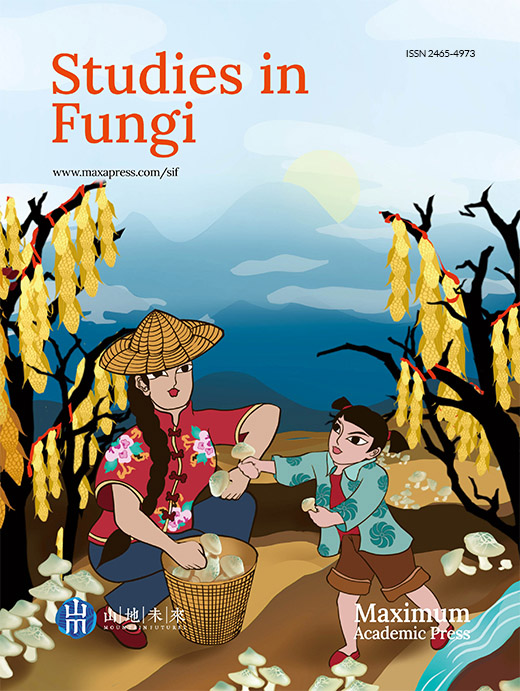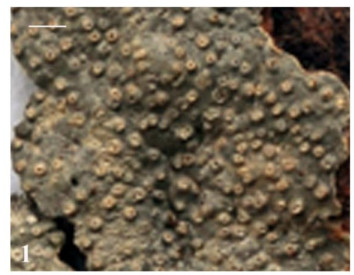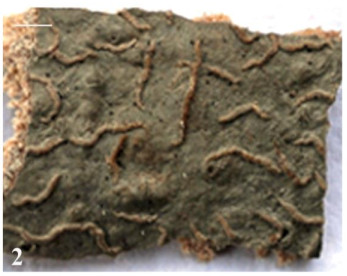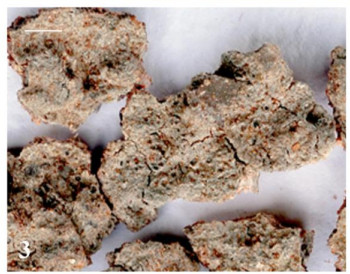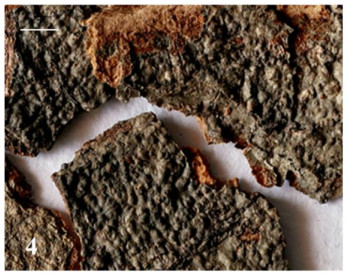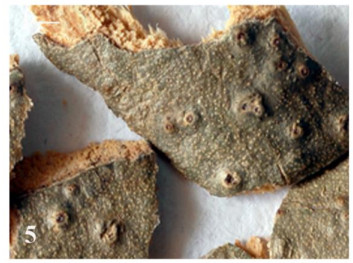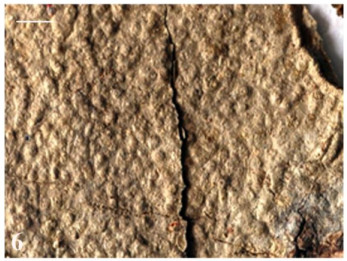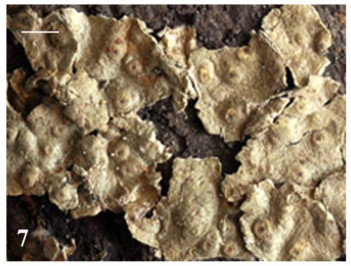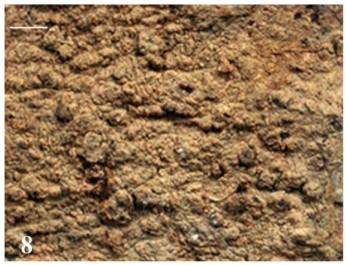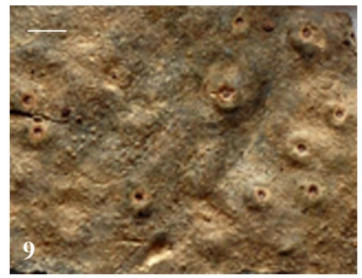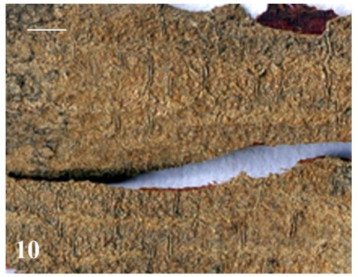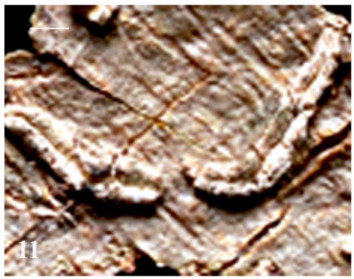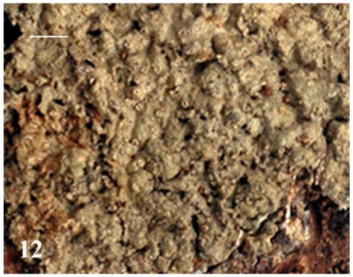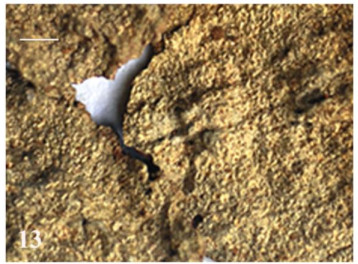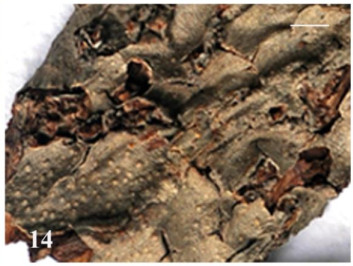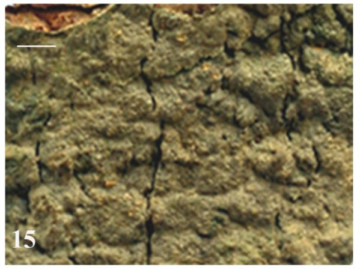HTML
-
The Western Ghats is internationally known as hotspot for biological diversity. It comprises a series of mountains parallel to India's western coast and stretches over 1, 600 km across the states of Kerala, Tamil Nadu, Karnataka, Goa, Maharashtra, and Gujarat, with a break of approximately 30-50 km at Palghat region (Nair & Moolakkattu 2017). The Western Ghats play a crucial role in controlling the weather of the Indian peninsula. They are particularly important for their endemism and have been listed as one of the eight hotspots of biological diversity globally (Nair & Moolakkattu 2017). In the world, about 20, 000 lichens are known while India is represented by 2714 species (Sinha et al. 2018), which is about 5.17% of the country's plants wealth (Singh & Dash 2017). Similar to flora and fauna, Western Ghats also has rich diversity of lichens represented by about 1650 species which form 60% of known lichens in India. Located in the Western Ghats, Kerala harbours rich diversity of lichens represented by approximately 800 species. Unfortunately, in Kerala state, the inventory of lichens has not received much attention when compared to other groups of plants. Only cursory studies have been carried out in lichenology from this region, which includes Silent Valley National Park in the Palghat district, New Amarambalam Reserve Forest in Malappuram district, Chembra, and Thirunelly in Wayanad district, forest areas in the Pathanamthitta district, and the montane forests of Kerala. There remain many ecologically interesting places such as Wildlife Sanctuaries, National Parks, Reserved Forests, Mangrove forests, and even the cultivated areas to be explored for the lichens.
In Kerala, the lichen study is mostly focused towards macrolichens. The state has equally rich diversity of microlichens represented by pyrenocarpous, graphidaceous and thelotremataceous lichens. Therefore, the aim of the present study is to enumerate the lichens belonging to family Graphidaceae in Kerala. Graphidaceae, the largest crustose family within Graphidales (Wijayawardene et al. 2020) comprising more than 2000 species, is widely distributed in tropical and subtropical regions of the world. An important feature in separating species and genera of Graphidaceae has traditionally been ascospore characteristics, i.e. septum and colour. Staiger (2002) made detailed study and proposed a new generic division in the family mainly based on molecular systematics, characters of ascospores and asci, types of paraphyses, colour and iodine reaction of ascospores and chemistry. Lücking et al. (2008) also studied Graphidaceae of Costa Rica and introduced few more genera. Since 2002, the taxonomy of the family has undergone major changes and, as a result, a large number of new genera have been established and several old genera resurrected based mainly on molecular studies (Staiger et al. 2006, Rivas Plata et al. 2012, 2013, Lücking et al. 2013, Lumbsch et al. 2014). These developments have also resulted in the transfer of many species from erstwhile established genera such as Graphina, Graphis, Phaeographina, Phaeographis and Helminthocarpon to other genera or newly introduced genera. Graphidaceae is now well circumscribed in terms of generic classification and species delimitation (Singh & Singh 2020). From Kerala, earlier about 200 species of Graphidaceae were known (Biju et al. 2012, 2014, Chitale et al. 2009, Easa 2003, Joshi et al. 2012, 2018, Sanjeeva & Upreti 2005, Sharma et al. 2012, Singh & Sinha 2010, Singh & Singh 2020, Sinha et al. 2018, Zachariah et al. 2018). In the present study, several interesting specimens are identified and reported as new to India or Kerala state.
-
The present study is based on the examination of more than 114 graphidaceous and thelotremataceous lichen specimens collected from different forest localities throughout the Kerala state, during 2006. The identification of all the taxa were done by studying their morphology, anatomy and chemistry and also referring the keys and standard descriptions available from the literature (Hale 1981, Joshi et al. 2018, Lumbsch et al. 2008, Medeiros et al. 2017, Patwardhan & Kulkarni 1977, Sharma et al. 2012, Singh & Singh 2015, Sutjaritturakan & Kalb 2015). Identified materials were also matched with types, exciccates and well identified materials housed at lichen herbarium LWG of CSIR-National Botanical Research Institute, Lucknow. The morphological details were examined using a stereo zoom Magnus MLX Plus microscope while anatomical details were studied using Leica DM2000 optical microscopes attached with camera and image analysis software. The chemistry was studied by spot tests and thin layer chromatography was performed in solvent system C following Orange et al. (2001). Lücking et al. (2017) was followed for classification of lichens. After confirming the identification of lichens, the specimens were housed at the regional herbarium of Jawaharlal Nehru Tropical Botanic Garden and Research Institute under TBGT and a set of voucher specimens are housed at herbarium LWG. Faces of fungi numbers were registered as described in Jayasiri et al. (2015).
-
Asteristion alboolivaceum (Vain.) I. Medeiros, Lücking & Lumbsch in Medeiros, Kraichak, Lücking, Mangold, Fieldiana, Life and Earth Sciences 9: 8 (2017) Fig. 1
Index Fungorum number: IF827510; Facesoffungi number: FoF09846
Thallus corticolous, thin, greenish glaucous, minutely warty; apothecia numerous, crowded, lepadinioid, white, emergent, ostiole broad, 0.3 mm in diameter, disc white pruinose, columella lacking, exciple thin, non-carbonized; ascospores 8 per ascus, cylindrical, 4-7 × 11-20 μm.
Chemistry - Thallus P+ yellow; TLC: Stictic and Constictic acid present.
Distribution - In India, the species is reported from Karnataka. Outside India it is reported from Australia, Puerto Rico and Sri Lanka (Singh & Sinha 2010). It is a new record to Kerala.
Specimens examined - India, Kerala, Trivandrum, Agasthyavanam Biological Park, on the way to Pongalappara, alt. 1140 m, 26 April 2006, B. Haridas, LWG s. n., TBGT 541; Peppara Wildlife Sanctuary, alt. 140 m, 19 October 2006, B. Haridas, LWG s. n., TBGT 1207.
Chapsa hiata (Hale) Sipman, in Sipman, Lücking, Aptroot, Chaves, Kalb & Umana Tenorio, Phytotaxa 55: 38 (2012) Fig. 2
Index Fungorum number: IF 800065; Faces of fungi number: FoF 09847
Thallus corticolous, greenish grey, smooth to often granular, thick, epiphloedal, 30-80 μm; apothecia semi-emergent, chroodiscoid, 0.4-0.7 mm diam., disc wide open, epruinose, 400-500 μm across; exciple free with periphysoids, non-carbonized, recurved; ascospores hyaline, muriform, transversely 4-8 septate, vertically one septate, 4-8 × 14-17 μm.
Chemistry - No chemical substance present.
Distribution - In India, the species is reported from Assam, Karnataka, Orissa and Eastern Himalayas (Patwardhan et al. 1985, Joshi et al. 2018). Outside India, it is reported from Panama (Singh & Sinha 2010). It is a new record to Kerala.
Specimens examined - India, Kerala, Trivandrum, Agasthyavanam Biological Park, on the way to Pongalappara, alt. 1140 m, 26 April 2006, B. Haridas, LWG s. n., TBGT 562, 563.
Diploschistes rampoddensis (Nyl.) Zahlbr. Cat. Lich. Univ. 2: 665. 1924; D. D. Awasthi & Kr. P. Singh, Geophytology 5(1): 111. 1975; G. Pant & Upreti, Lichenologist 25(1): 46. 1993 Fig. 3
Index Fungorum number: IF384471; Facesoffungi number: FoF09848
Thallus saxicolous, ashy grey, cracked to often verruculose, 70-120 μm thick; ascocarps apothecioid, partially immersed, compactly arranged, often adnate, up to 1 mm in diam., margin prominent, thick, entire, concolourous with thallus, disc blackish, open, pruinose; proper exciple dark, 30-50 μm thick; thalline exciple usually broken in marginal region; epithecium granular, 7-10 μm thick; hymenium colourless, 100-120 μm high; hypothecium colourless above, brownish below; asci 8-spored, 50-75 × 15-20 μm; ascospores oval to ellipsoidal, with 5-6 transverse and 1-2 longitudinal septa, 17-25 × 8-10 μm.
Chemistry - No chemical substance present.
Distribution - In India, the species is distributed in Assam, Himachal Pradesh, Madhya Pradesh, Maharashtra (Joshi et al. 2018, Makhija et al. 2014) Nagaland, Sikkim (Sinha & Gupta 2017) Tamil Nadu, Uttarakhand and West Bengal. Outside India, it is reported from Nepal, New Guinea and Sri Lanka (Singh & Sinha 2010). It is a new record to Kerala.
Specimens examined - India, Kerala, Idukki, Munnar, towards Mattupetty, alt. 1580 m, 26 July 2006, B. Haridas, LWG s. n., TBGT 959.
Fissurina rubiginosa (Fée) Staiger. Biblioth. Lichenol. 85: 148. 2002 Fig. 4
Index Fungorum number: IF372514; Facesoffungi number: FoF09849
Thallus thin, smooth, whitish to pale grey or olive green; lirellae fissure like, sparse, disc inconspicuous, exciple uncarbonised, convergent, with crystals, hymenium hyaline, hypothecium indistinct, paraphyses about 1-1.5 μm, ascospores hyaline, muriform, 9-15 per 3-5 locular, 25-30 × 12-14 μm. I-.
Chemistry - No chemical substance present.
Distribution - In India, the species is reported only from Tamil Nadu (Sharma et al. 2012, Sinha et al. 2018). Outside India, it is reported from French Guyana and USA (Sharma et al. 2012), Thailand (Buaruang et al. 2017) and Vietnam (Joshi et al. 2013). It is a new record to Kerala.
Specimens examined - India, Kerala, Thrissur, Vazhachal, Riverside, alt. 220 m, 27 September 2006, B. Haridas, LWG 06-008423, TBGT 1119.
Ocellularia albomaculata Hale, Bull. Br. Mus. nat. Hist., Bot. 8: 300. 1981 Fig. 5
Index Fungorum number: IF11 2074; Facesoffungi number: FoF09850
Thallus crustose, corticolous, verruculose, white spotted; apothecia 0.8-1.2 mm diam., exciple carbonized, columella present, simple, 250-300 μm diam., spores brown, muriform, 20-30 × -10 μm; with 3 transverse and 0-1 vertical septa.
Chemistry - No chemical substance present.
Distribution - Earlier the species is reported from Sri Lanka (Hale 1981), Cuba (Lücking & Pörez-Ortega 2015) and Thailand (Buaruang et al. 2017) and is a new record for Indian lichen biota.
Specimens examined - India, Kerala, Kollam, Rosemala, 27 June 2006, B. Haridas, LWG s. n., TBGT 801.
Ocellularia ascidioidea Hale, Bull. Br. Mus. nat. Hist., Bot. 8: 300. 1981 Fig. 6
Index Fungorum number: IF112480; Facesoffungi number: FoF09851
Thallus corticolous, crustose, shiny, corticate, whitish or mineral grey; medulla white; apothecia moderately emergent, 0.8-1.0 mm diam., pore 0.2-0.3 mm diam., exciple carbonized, columella 150-190 μm diam., often filling the pore, spores colourless, transversely septate, 5-7 septate, 18-30 × 5-8 μm, I + blue.
Chemistry - No chemical substance present.
Distribution - Earlier the species is reported from Seychelles (Diederich et al. 2017), Sri Lanka (Hale 1981), New Caledonia (Kraichak et al. 2014) and Thailand (Buaruang et al. 2017). It is a new record for Indian lichen biota.
Specimens examined - India, Kerala, Ernakulam, Thattekkad Bird Sanctuary, alt. 360 m, 21 December 2006, B. Haridas, LWG s. n., TBGT 1543.
Ocellularia kanneliyensis Hale, Bull. Br. Mus. nat. Hist., Bot. 8(3): 308. 1981 Fig. 7
Index Fungorum number: IF 112483; Faces of fungi number: FoF09852
Thallus crustose, pale brownish to grey, cortex dense, medulla well developed, apothecia strongly emergent, 1.2-1.5 mm diam., pore 0.3-0.5 mm diam., exciple carbonized, columella absent, spores colourless, transversely septate, 24-33 × 6-7 μm, 5-7 septate, I + blue.
Chemistry - P+ yellow to orange red; TLC: Hypocetraric acid and an unknown substance present.
Distribution - So far, the species is known from Sri Lanka (Hale 1981) and is a new record to Indian lichen biota.
Specimens examined - India, Kerala, Thrissur, Vazhachal, Peringolkuthu, alt. 400 m, 27 September 2006, B. Haridas, LWG s. n., TBGT 1088.
Ocellularia monosporoides (Nyl.) Hale, Mycotaxon 11: 137. 1980 Fig. 8
Index Fungorum number: IF113649; Facesoffungi number: FoF 09853
Thallus pale green to straw coloured, 2-5 cm broad, thick, dull, smooth to often verruculose, fissured; cortex dense, 15-20 μm; algal layer continuous, 10-15 μm; medulla 10-15 μm with crystals, mostly hypophloeodal; apothecia semi-emergent, up to 1 mm diam., the exciple carbonized apically; columella lacking; pore variable, round up to 1.2 mm diam., often depressed; hymenium 250-280 μm; spores colourless to pale brown, muriform, 30-35 × 120-200 μm, with numerous locules.
Chemistry - No chemical substance present.
Distribution - Earlier the species is reported from New Zealand (Hayward & Hayward 1991), Sri Lanka (Hale 1981) and Thailand (Buaruang et al. 2017), is a new record for Indian lichen biota.
Specimens examined - India, Kerala, Thrissur, Vazhachal, Riverside, alt. 220 m, 27 September 2006, B. Haridas, LWG s. n., TBGT 1012.
Ocellularia pertusariiformis (Leight.) Zahlbr., Cat. Lich. Univ. 2: 598. 1923 Fig. 9
Index Fungorum number: IF536439; Facesoffungi number: FoF09854
Thallus mineral grey, 3-5 cm broad, smooth to verruculose, continuous, cortex cellular, 7-10 μm, with aculeate hyphae; algal layer continuous, 15 μm; medulla 10-50 μm with some crystals; apothecia conspicuous, emergent and basally constricted, warty, up to 1 mm diam., the exciple fused reddish brown; columella lacking; pore area flattened to depressed, pore up to 0.07 mm diam., white rimmed, hymenium 300-400 μm; spores colourless, transversely septate, 28-30 × 100-130 μm, 11-12 loculate.
Chemistry - Unknown lichen substance present.
Distribution - Earlier the species is reported from Philippines (Kraichak et al. 2014), Sri Lanka (Hale 1981) and Thailand (Buaruang et al. 2017) is a new record for Indian lichen biota.
Specimens examined - India, Kerala, Kollam, Rosemala, 27 June 2006, B. Haridas, LWG s. n., TBGT 746.
Ocellularia rhicnopora Hale, Bull. Br. Mus. nat. Hist., Bot. 8: 322. 1981 Fig. 10
Index Fungorum number: IF112493; Facesoffungi number: FoF09855
Thallus pale yellowish brown, 12-15 cm broad, verruculose to sub granular; cortex loosely organized, 20-24 μm; algal layer continuous, 15 μm; medulla 15-20 μm, mostly hypophloeodal; apothecia irregularly dispersed, semi-emergent, up to 0.1 mm diam., the exciple carbonized; columella lacking; pore irregular, up to 0.2 mm diam., the surrounding area pale brown, rugose; hymenium 60-90 μm; spores colourless, transversely septate, 8 × 30 μm, 7-9 loculate.
Chemistry - No chemical substance present.
Distribution - Earlier the species is reported from Sri Lanka (Hale 1981), is a new record for Indian lichen biota.
Specimens examined - India, Kerala, Ernakulam, Thattekkad Bird Sanctuary, KERALA, alt.
400 m, 21 December 2006, B. Haridas, LWG s. n., TBGT 1513.
Pallidogramme chrysenteron (Mont.) Staiger & al. In Lücking & al., Fieldiana, Bot. 46: 9. 2008 Fig. 11
Index Fungorum number: IF508699; Facesoffungi number: FoF09856
Thallus corticolous, crustaceous, epiphloedal, brown, thin. Apothecia lirellate, lirellae prominent, well emergent, simple to furcated, straight to curved and flexuous, 1.0-5.0 mm long; ends obtuse to acute; margin thick, striate, concolourous to thallus, disc close; exciple open, pale brown, basally plane, much expanded upper region, labia two to multi-sulcate, with few black stripes, convergent covered with thin thalline veil, crystals present near the base on the outer side of exciple. Hymenium hyaline inspersed, 100-160 μm high; hypothecium hyaline, 15-28 μm thick. Asci 8-spored; ascospores hyaline to brown, muriform, oblong to ellipsoid, transversely 9-18 locular, 50-75 × 10-20 μm.
Chemistry - Thallus K+ red, P+ yellow to orange; TLC: Stictic acid complex present.
Distribution - In India, the taxon is reported from Arunachal Pradesh, Manipur, Meghalaya, Nagaland and Sikkim (Singh & Singh 2015). Outside India, it is reported from Sri Lanka (Singh & Sinha 2010). It is new to Peninsular India.
Specimens examined - India, Kerala, Trivandrum, Agasthyavanam Biological Park, Athirumala, Pathalamatty, alt. 1190 m, 25 April 2006, B. Haridas, LWG 06-008409, TBGT 438.
Pseudochapsa phlyctidioides (Müll. Arg.) Parnmen, Lücking & Lumbsch, PLoS ONE 7(12): e51392, 10. 2012 Fig. 12
Index Fungorum number: IF801528; Facesoffungi number: FoF09857
Thallus crustose, corticolous, photobiont green alga; apothecia not chroodiscoid, flush to semi emergent, 0.4-0.6 mm diam.; thalline rim sub erect, exciple free apically, filling the disc at maturity, disc not pigmented, spores colourless, transversely septate, 4-7 septate, 12-20 × 4-5 μm, I + blue.
Chemistry - Thallus P+ orange; TLC: Stictic and Constictic acid present.
Distribution - In India, the taxon is reported only from Andaman Islands (Sethy et al. 2012). Out side India, it is reported from Sri Lanka, Central America, Australia and West Indies (Hale 1981). It is new to Kerala.
Specimens examined - India, Kerala, Trivandrum, Peppara Wildlife Sanctuary, Nellikkapara, alt. 200 m, 17 October 2006, B. Haridas, LWG s. n., TBGT 1270.
Thelotrema canarense Patw. & C. R. Kulk., Norweg. J. Bot. 24: 128. 1977; A. Frisch, Biblioth. Lichenol. 92: 285. 2006. Fig. 13
Index Fungorum number: IF343726; Facesoffungi number: FoF09858
Thallus corticolous, yellowish brown, smooth to often wrinkled, mostly hypophloeodal; apothecia mostly immersed, concolourous with thallus; ostiole moderately open, proper exciple thin, brown, separate; columella absent; ascospores 8 per ascus, ellipsoid, muriform, hyaline, with 7-8 transverse septa, 1 vertical septum, 4-8 × 18-25 μm.
Chemistry - Thallus P+ orange; TLC: Norstictic acid present.
Distribution - In India, the species is reported from Karnataka (Nayaka & Upreti 2005, Vinayaka 2016), Uttarakhand, West Bengal and Western and Eastern Himalayas (Joshi et al. 2018). Outside India, it is reported from Kenya (Kirika et al. 2012), Tanzania (Frisch et al. 2006), Thailand (Buaruang et al. 2017). It is new to Kerala.
Specimens examined - India, Kerala, Kollam, Rosemala, 28 June 2006, B. Haridas, LWG s. n., TBGT 843.
Thelotrema piluliferum Tuck., Proc. Amer. Acad. Arts & Sci. 7: 277. 1868. Fig. 14
Index Fungorum number: IF407419; Facesoffungi number: FoF09859
Thallus corticolous, crustose, grey, photobiont green alga; apothecia 0.7-1.0 mm diam., emergent, urieolate pore 0.05 mm diam., exciple fused, yellow brown, ascospores 8 per ascus, muriform, colourless, 3-5 transverse and 0-2 vertical septa, 24-28 × 8-12 μm, I + blue.
Chemistry - P+ yellow-orange; TLC: Psoromic acid present.
Distribution - In India, the species is reported from Maharashtra. Outside India, the taxon is known from Sri Lanka, Hawaii and Sabah (Hale 1981). It is new to Kerala.
Specimens examined - India, Kerala, Trivandrum, Agasthyavanam Biological Park, Athirumala, Pathalamatty, alt. 1200 m, 25 April 2006, B. Haridas, LWG s. n., TBGT 568.
Thelotrema subtile Tuck., Amer. J. Sci. Arts, ser. 2, 25: 426. 1858; A. Frisch, Biblioth. Lichenol. 92: 318. 2006 Fig. 15
Index Fungorum number: IF121481; Facesoffungi number: FoF09860
Thallus corticolous, olivaceous to pale grey, rough, often epiphloedal to hypophloeodal; apothecia numerous, crowded, immersed to semi-emergent, ecolumellate, lepadinioid, disc white pruinose, ascospores 8 per ascus, 5-7 loculate, lenticular, 7-10 × 23-30 μm.
Chemistry - No chemical substance present.
Distribution - In India, the species is reported from Karnataka and Maharashtra. Outside India it is reported from Australia, Bhutan, New Caledonia, Hawaiian Islands, Indonesia, Ireland, Japan, Java, New Zealand, Scotland, Sweden, Philippines and USA (Nagarkar et al. 1988, Singh & Sinha 2010). It is new to Kerala.
Specimens examined - India, Kerala, Kollam, Rosemala, 28 June 2006, B. Haridas, LWG s. n., TBGT 732.
-
A total of 570 Graphidaceae species are known from India (Singh & Sinha 2010, Sinha et al. 2018). Graphidaceae is the largest occurring family in Kerala representing 214 species under 40 genera followed by Parmeliaceae and Pyrenulaceae with 146 and 63 species respectively. Further, in comparison to other states within the Western Ghats, Kerala also holds the largest number of Graphidaceous lichens followed by Karnataka with 178 and Tamil Nadu with 174 species (compilation from published literature). The present information on Graphidaceous lichens will be helpful as a baseline record to the lichen flora of Kerala and can be used for biomonitoring studies in the future. However, an extensive and intensive survey will definitely add a greater number of taxa.
-
The authors gratefully acknowledge Kerala State Council for Science, Technology and Environment (KSCSTE) for financing the project work and Dr R. Prakash Kumar, Director, KSCSTE - JNTBGRI for providing facilities. We are thankful to D. K. Upreti (CSIR-NBRI, Lucknow) for confirming the identity of lichen samples and Kerala Forest Department for permitting sample collection from the various forest localities of Kerala.
- Copyright: © 2021 by the author(s). This article is an open access article distributed under Creative Commons Attribution License (CC BY 4.0), visit https://creativecommons.org/licenses/by/4.0/.
| H Biju, A Sabeena, S Nayaka. 2021. New records of Graphidaceae (lichenized fungi) from the Western Ghats of Kerala state, India. Studies in Fungi 6(1):213−223 doi: 10.5943/sif/6/1/14 |


